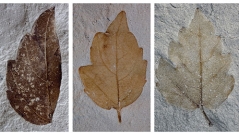

 Comptes Rendus Palevol
18 (8) - Pages 925-947
Comptes Rendus Palevol
18 (8) - Pages 925-947The Eocene–Oligocene transition (EOT) climatic turnover is modelled in the Ebro Basin using CLAMP and analysing the Sarral (Priabonian) and the Cervera (Rupelian) floras. The results show a drop of temperature and an increase in seasonality and precipitation. The changes in temperature and seasonality follow the trend described for the EOT in southern Europe; however, the increase in precipitation is the opposite of what would be expected. This increase might be related to the stratigraphic location of the Sarral Priabonian leaf bed within a dry stage of a precession cycle, whereas the Cervera Rupelian leaf bed would be located within the wet stage of a similar cycle. CLAMP combined with sedimentology, taphonomy and palaeoecology reveals that precession cycles would produce a shift in the habitat of certain plants during the EOT, with the Lauraceae being limited to riparian communities during the Priabonian of Sarral to grow in small laurisilvas during the Rupelian of Cervera.
Cenozoic, Grande Coupure, vegetation, lacustrine deposits, orbital forcing